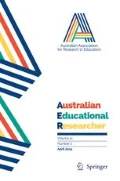Abstract
In recent years the educational policy environment has emphasised data-driven change. This has increased the expectation for school personnel to use statistical information to inform their programs and to improve teaching practices. Such data include system reports of student achievement tests and socio-economic profiles provided to schools by various state education departments’ data services. This paper reports on a pilot study that explored factors affecting Mathematics and English teachers’ intentions to engage with the statistical data their schools receive and to consider these data when making decisions about their teaching practices. It was found that most teachers perceived that such data identify weak students and some teachers (mostly mathematics teachers) thought that they can help to identify curriculum topics that need attention. Most teachers felt that the reports were not easy to understand. Confidence in dealing with statistical data was a problem for many teachers, but especially for English teachers.
Similar content being viewed by others
References
Aizen, I. (1991). The theory of planned behaviour. Organizational Behavior and Human Decision Processes, 50, 197–211.
Armitage, C., & Conner, M. (2001). Efficacy of the theory of planned behaviour: A meta-analytic review. British Journal of Social Psychology, 40, 471–499.
Francis, J., Eccles, M., Johnston, M., Walker, A., Grimshaw, J., Foy, R., et al. (2004). Constructing questionnaires on the theory of planned behaviour: A manual for health services research. Newcastle-upon Tyne, UK: University of Newcastle, UK.
Gal, I., Ginsburg, L., & Schau, C. (1997). Monitoring attitudes and beliefs in statistics education. In I. Gal & J. B. Garfield (Eds.), The assessment challenge in statistics education (pp. 37–51). Amsterdam: IOS Press and the International Statistics Institute.
Jones, B., & Egley, R. (2007). Learning to take tests or learning for understanding? Teachers’ beliefs about test-based accountability. The Educational Forum, 71(3), 232–248.
Loudy, W., & Wildy, H. (2001). Developing schools’ capacity to make performance judgements. http://www.dest.gov.au/archive/schools/literacyandnumeracy/publications/dataclub/dataclub_report.pdf. Accessed April 29 2009.
Matthews, J., Trimble, S., & Gay, A. (2007). But what do you do with the data? Principal Leadership, 7(9), 31–33.
Ministerial Council for Education, Early Childhood Development and Youth Affairs. (2009). National assessment program: Literacy and numeracy. http://www.naplan.edu.au. Accessed August 18 2009.
Ministerial Council on Education, Employment, Training and Youth Affairs. (n.d.). Benefits of participating in national assessments. http://www.mceetya.edu.au/verve/_resources/Benefits_of_participation_in_national_assessments1.pdf. Accessed May 8 2008.
Nichols, S., & Berliner, D. (2008). Testing the joy out of learning. Educational Leadership, 65(6), 14–18.
Organization for Economic Cooperation and Development. (2004). Reviews of National Policies for Education: Chile. Paris: Author.
Pierce, R. (1989). Mathematics anxiety: An inhibiting factor in tertiary education. In Proceedings of the 12th annual conference of the mathematics education research group of Australasia. Bathurst: Charles Sturt University.
Pierce, R. (1995). Research on mature-age students returning to study mathematics at tertiary level. Geelong: Deakin University.
Pierce, R., & Ball, L. (2009). Perceptions which may affect teachers’ intention to use technology in secondary mathematics classes. Educational Studies in Mathematics, 71, 299–317.
Prochaska, J., & DiClemente, C. (1983). Stages and processes of self-change of smoking: Towards an integrative model of change. Journal of Consulting Clinical Psychology, 51, 390–395.
Roehrig, A., Walton Duggar, S., Moats, L., Glover, M., & Mincey, B. (2008). When teachers work to use progress monitoring data to inform literacy instruction: Identifying potential supports and challenges. Remedial and Special Education, 29, 364–382.
Statistical Society of Australia Inc. (2005). Statistics at Australian universities: An SSAI sponsored review. ACT: Author.
Victorian Curriculum and Assessment Authority. (2009). Achievement Improvement Monitor (AIM). http://www.vcaa.vic.edu.au/prep10/aim/aimindex2.html. Accessed August 18 2009.
Wallman, K. K. (1993). Enhancing statistical literacy: Enriching our society. Journal of the American Statistical Association, 88(421), 1–8.
Acknowledgments
Part of this research was funded by a grant from the Melbourne Graduate School of Education at the University of Melbourne. The authors thank Roger Wander for his work as a research assistant on this project, and Professor Jane Watson for feedback on a draft of this paper.
Author information
Authors and Affiliations
Corresponding author
Rights and permissions
About this article
Cite this article
Pierce, R., Chick, H. Teachers’ intentions to use national literacy and numeracy assessment data: a pilot study. Aust. Educ. Res. 38, 433–447 (2011). https://doi.org/10.1007/s13384-011-0040-x
Published:
Issue Date:
DOI: https://doi.org/10.1007/s13384-011-0040-x



